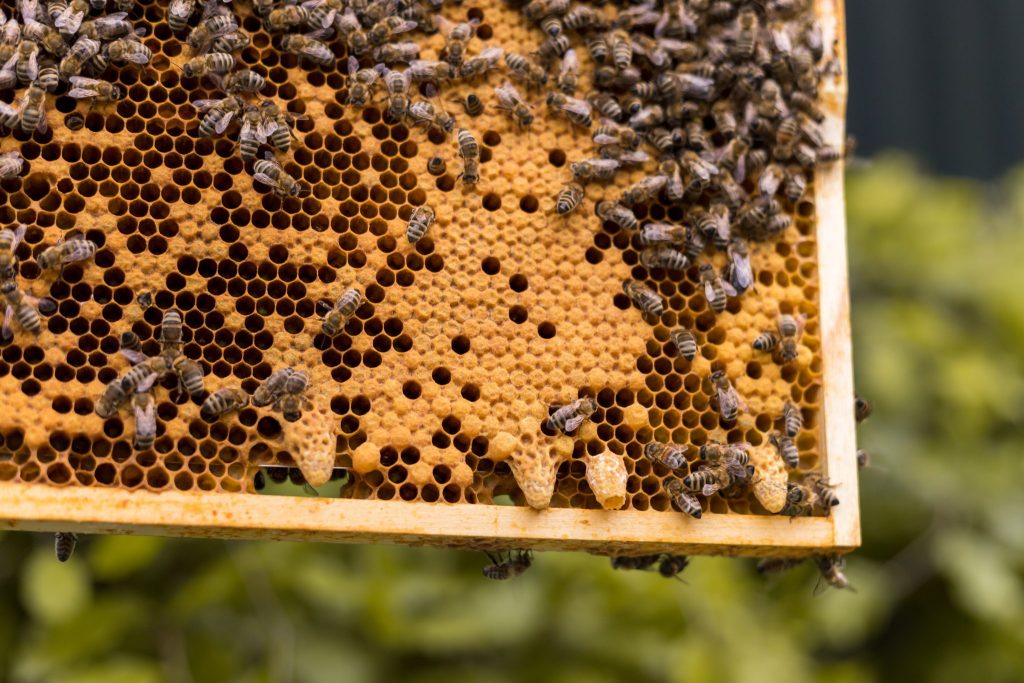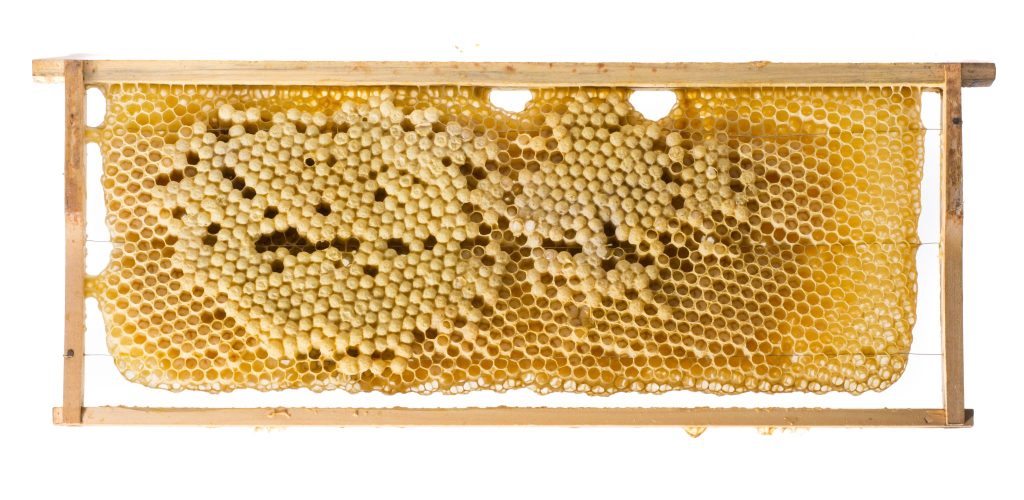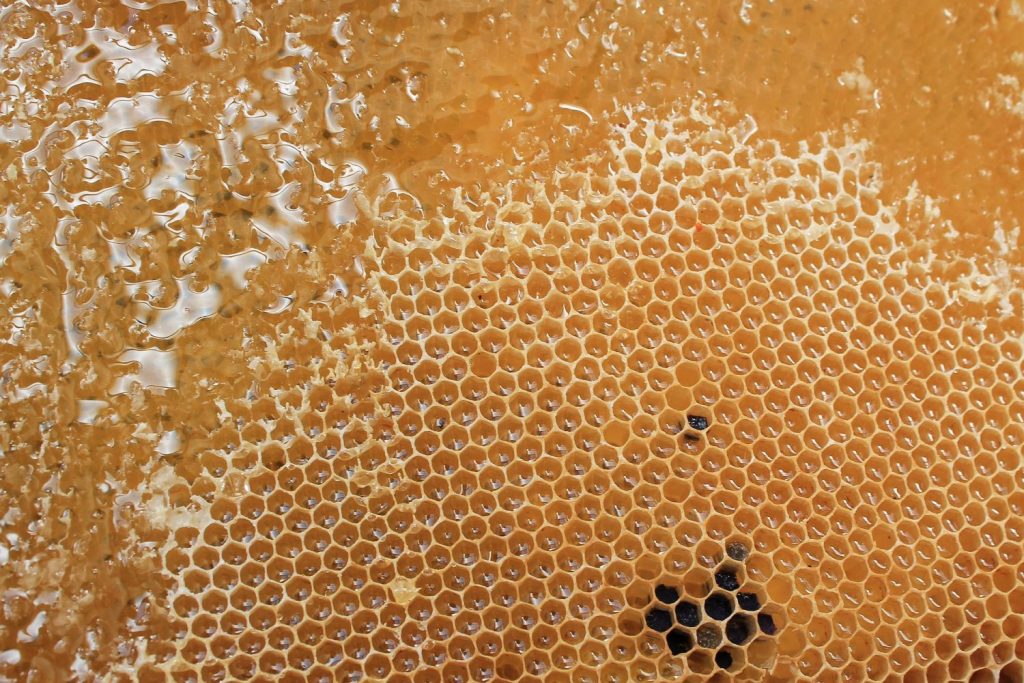If you purchase an independently reviewed item through our site, we earn an affiliate commission. Read our affiliate disclosure.
The success of any honeybee colony boils down to its organization at the core. Drone and queen cells play an important role in the honeybee colony, housing the male honeybees and future queens, respectively. These spectacular structures are built by the worker bees and have been a subject of study for decades.
Honeybees are, without a doubt, expert architects and manufacturers. They may be tiny insects but are the only ones that produce food products that can be consumed by humans. They also build perfectly-sized honeycombs or cells that house brood and store, honey. Both drone and queen cells have distinguishing features that shall be discussed in this article.
Drone and Queen Cells
About Queen Cells

Queen cells are of three types: swarm, supersedure and emergency. Each of these cells produces the queen but their intention or purpose for building these cells differs.
1. Supersedure Cells
The worker bees will build supersedure cells when current the queen is no longer productive due to age or ill health. This means she is no longer able to produce enough eggs or brood to sustain the colony. In other words, the number of dying bees exceeds the number of bees hatching. If this is the case, then the future of the colony is jeopardized.
The worker bees will build supersedure cells for these reasons:
- The queen is no longer productive due to aging.
- A sick queen that cannot produce enough eggs.
- The queen no longer has the genetic material required for fertilizing eggs.
The supersedure cells will be created often in the middle of a honeycomb. The worker bees will utilize an already existing egg and will begin to feed the larva in the cell on royal jelly. Interestingly, if this larva is fed on honey instead, it will develop into a regular worker bee.
A supersedure cell will usually hang down at the front of the honeycomb. This is its differentiating feature. You will find more than one supersedure cell at front combs, mainly for the purpose of boosting the possibility of raising a healthy queen bee. There will usually be 2 to 3 supersedure cells.
It will take about 16 days for a queen to emerge from its cell. Once this duration has lapsed, she will signal the worker bees through their pipping sound. The worker bees will then chew through the wax, making way for the young queen bee.
2. Swarm Cells
As for swarm cells, these can easily be differentiated based on where the cells are situated. It is strikingly similar to supersedure cells, and thus location can help you know the difference. Swarm cells will be built by worker bees on a frame. These are built on margins or the bottom of the combs. They will therefore be seen hanging in these areas.
You might also find swarm cells on the upper brood box, usually hanging on the lower edges. For honeybees, there is usually no clear rule to stick to when it comes to building queen cells. Often, this can mislead the beekeeper. Conversely, swarm cells will be built when the colony is in need of a new queen, more often when the colony has grown and needs to split into two. As for supersedure cells, they will be built when the existing queen is dead or needs to be replaced.
3. Emergency Queen Cells
Lastly, there are the emergency queen cells which are typically created when the queen dies unexpectedly.
About Drone Cells
Drone cells are larger than worker cells and are usually positioned on the edges of the brood. This is a strategic location, given the fact that brood larvae do well under lower temperatures. The position helps lower the temperature condition by one or two degrees. These cells have a dome-shaped cap that is larger than worker cells.
Comparing Drone and Queen Cells

The differences and similarities between drone and queen cells are apparent. These are explained below:
Differences
- The drone cells are almost always created on the edges of the brood section. This is unlike queen cells which are positioned based on the purpose. The reason for the positioning of drone cells has to do with the temperature requirements of drone larvae.
- The capping on drone cells is easily distinguishable. It has a striking dome shape and is larger when compared to worker cells but smaller than queen cells. Queen cells have a peanut shape and are created for a purpose. They are approximately one inch long and lay horizontally above the comb. Drones with their slightly rounded protrusions result in a bullet shape that is easy to point out. It is almost impossible not to notice a group of drone cells within honeycomb.
- There is a big difference in the number of drone and queen cells at any given time. Supersedure cells will usually be 2 or 3 and swarm cells a little bit more, usually more than 3 and perhaps between 10 to 20. For drone cells things are different. Feral or wild bees will build drone combs in hundreds and will usually be about 30% drone cells within the colony. This is attributable to the fact that a higher number guarantees their survival in such a harsh environment.
- The drone cells usually exist in groups and will usually be about 100 or more in number and within the same area. Contrastingly, queen cells can be spotted almost anywhere within the honeycomb or the frame. They are not grouped within a specific location as the drone cells.
- The queen cells will be opened by the worker bees after 16 days. This is the time it takes for the queen larva to develop and emerge from its cell. As for a drone cell, it will take 24 days for the larva to mature into a fully grown male bee.
- Queen cells are built on an egg that is already laid. Consequently, a queen cell is found in the middle or on the edges of a comb. The larva in the cells is then fed solely on royal jelly leading to the formation of a queen bee. This is not the case when it comes to a drone cell. In this case, the cell is fully dedicated to nurturing a drone bee and this is clear from the start. Therefore, worker bees will not build drone cells just anywhere on a comb. The drone larva is also not fed solely on royal jelly.
- Mites tend to prefer drone cells since these take longer to hatch. They also enjoy the comfort and abundance of food within these cells. Since these cells are rounded and larger in diameter it also takes much longer for them to be capped. This thus gives the mites enough time to get into the cells. On the flip side, queen cells are not preferred by mites.
- The number of drone cells in the honeybee colony will vary depending on factors such as: season, genetics, and weather condition. This does not apply to queen cells. The latter will be built based on the colony’s needs. Swarm cells are created when there is a need to split the colony into two whereas supersedure cells are created when a queen needs to be replaced.
- Queen cells such as swarm cells are more common during summer months when honeybee colonies expand rapidly. Supersedure and emergency cells can be created at any time depending on the colony’s need. As for drone cells, these are usually created in huge numbers prior to peak seasons, usually during spring. The main aim is for these male bees to mate with the queen bee once she is ready to mate.
- Queen cells will always point downwards and have a peanut shape with openings that point downwards. You can also see a large pool of royal jelly inside these cells when you examine the interior. The drone cells tend to be large, occupy the same position as worker cells, and have cupped tops.
Similarities
- While checking honeycombs, you can easily distinguish both queen and drone cells since these protrude from the surface of the honeycombs. This is unlike honey storage or worker cells which usually tend to be flat by design.
- Both queen and drone cells are built by the worker bees using wax secreted from specialized glands.
- Queen pupa is unable to chew through the wax capping on the cell once it is mature and ready to join the pack. They have to be assisted by worker bees. They will thus send signals once they are ready to emerge from their cells. As for drone bees, they need assistance as well from the worker bees just like the queen bees.
- Both queen and drone cells are larger than a worker or honey storage cells. This is obviously due to the size of the queen and drone bee. However, queen cells are larger than the drone cells.
The Making of Honeycombs
Separate from drone and queen cells are regular honeycombs – hexagonally shaped cells which house all the other things necessary for the survival and thriving of the colony – honey and pollen food stores, and worker bee brood. Indeed, honeycomb is essential for the survival of any honeybee colony. The brood will develop into young bees that will grow to be the future colony. Food reserves will also sustain the colony throughout the changing seasons, more so, during periods of dearth such as winter.
Honeycombs are built by the worker bees from beeswax, a substance that is secreted from special organs within the worker bee’s body. These glands secrete the wax scales when the required conditions are in place. These wax scales are chewed and mixed with honey and pollen resulting in the formation of beeswax.
The process of building honeycombs is never an easy one. Worker bees consume plenty of honey in the process since this is their main source of energy. This honey is made from nectar and pollen usually sourced from flowering plants. Honeybees require honey for their survival and reproduction. Without energy, it becomes impossible to produce wax. Additionally, the task of making honey is tedious and will also require energy. A single honeybee will therefore visit so many flowers just to make a few ounces of honey. It is believed that a single worker bee makes 1/12 teaspoon of honey in a lifetime on average. On the same note, a single worker bee has to visit about 2 million flowers if it has to produce 1 pound of honey.
Honeycomb building takes skill and experience. The worker bees have to maintain a proper balance between wax production, and energy expended on building combs. The wax should not be wasted, and neither should the honey consumed in the process be wasted. The ultimate goal is to utilize the least amount of wax possible in building honeycombs, which should hold the maximum amount of honey possible.
Conclusion
For starters, it might seem hard to identify the different cells in the honeycombs. It also proves challenging for a starter to understand how to deal with the different cells. Your first beehive inspection exercise will prove to be the most trying. For instance, the sight of queen cells may cause panic since some beekeepers may advise you to destroy these cells. Too many drone cells might also appear to be unwelcome and you might be tempted to believe the colony is in serious trouble.
Fortunately, honeybees are intuitive creatures that have been surviving for many years, without human intervention. Every action they take has a purpose and therefore you will never find these cells without any apparent motive. It is however important to comprehend why honeybees build these cells. More so, it proves wise to understand drone and queen cells. That way, you will be able to tell what is happening or predict what is anticipated to happen depending on the cells created by the worker bees.
References
- https://www.beepods.com/teacups-swarm-cells-supersedures-emergency-queen-cells/
- https://www.dadant.com/learn/identify-queen-cells/
- https://www.reddit.com/r/Beekeeping/comments/38tk4k/these_are_just_drone_cells_on_an_edge_not_queen/
- https://www.youtube.com/watch?v=znv9CicH5OQ
- https://americanbeejournal.com/working-with-queen-cells/
What are your thoughts on this article? Leave a comment below and let us know.
 BeeKeepClub Resources and Guides for Beekeepers
BeeKeepClub Resources and Guides for Beekeepers


Interesting